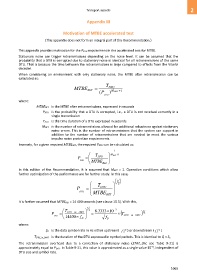Page 1075 - 5G Basics - Core Network Aspects
P. 1075
Transport aspects 2
Appendix III
Motivation of MTBE accelerated test
(This appendix does not form an integral part of this Recommendation.)
This appendix provides motivation for the PDTU requirement in the accelerated test for MTBE.
Stationary noise can trigger retransmissions depending on the noise level. It can be assumed that the
probability that a DTU is corrupted due to stationary noise is identical for all retransmissions of the same
DTU. That is because the time between the retransmissions is large compared to effects from the Viterbi
decoder.
When considering an environment with only stationary noise, the MTBE after retransmission can be
calculated as:
T
MTBE DTU
RET
(P ) M RET 1
DTU
where:
MTBERET is the MTBE after retransmissions, expressed in seconds
PDTU is the probability that a DTU is corrupted, i.e., a DTU is not received correctly in a
single transmission
TDTU is the time duration of a DTU expressed in seconds
MRET is the number of retransmissions allowed for additional robustness against stationary
noise errors. This is the number of retransmissions that the system can support in
addition to the number of retransmissions that are needed to meet the various
impulse noise protection requirements.
Inversely, for a given required MTBERET, the required PDTU can be calculated as:
1
T M RET 1
P DTU
DTU MTBE
RET
In this edition of the Recommendation, it is assumed that MRET = 1. Operation conditions which allow
further optimization of the performance are for further study. In this case,
1
T 2
P DTU
DTU MTBE
RET
It is further assumed that MTBERET = 14 400 seconds (see clause 10.3). With this,
1
T 2 . 8 3333 10 3 1
P DTU _ in _ DMT T 2
DTU 14400 f D f DTU _ in _ DMT
D
where:
fD is the data symbol rate in Hz either upstream( f US ) or downstream ( f DS )
D D
TDTU_in_DMT is the duration of the DTU expressed in symbol periods. This is identical to Q × S1.
The retransmission overhead due to a correction of stationary noise (STAT_OH, see Table 9-21) is
–4
approximately equal to PDTU. In Table 9-21, this value is approximated as a single value 10 , independent of
DTU size and symbol rate.
1065

